Easy Dream Garden
Sunday, June 20, 2021
Thursday, May 14, 2020
Select Increases to Muni Service Frequency Starting May 16
By
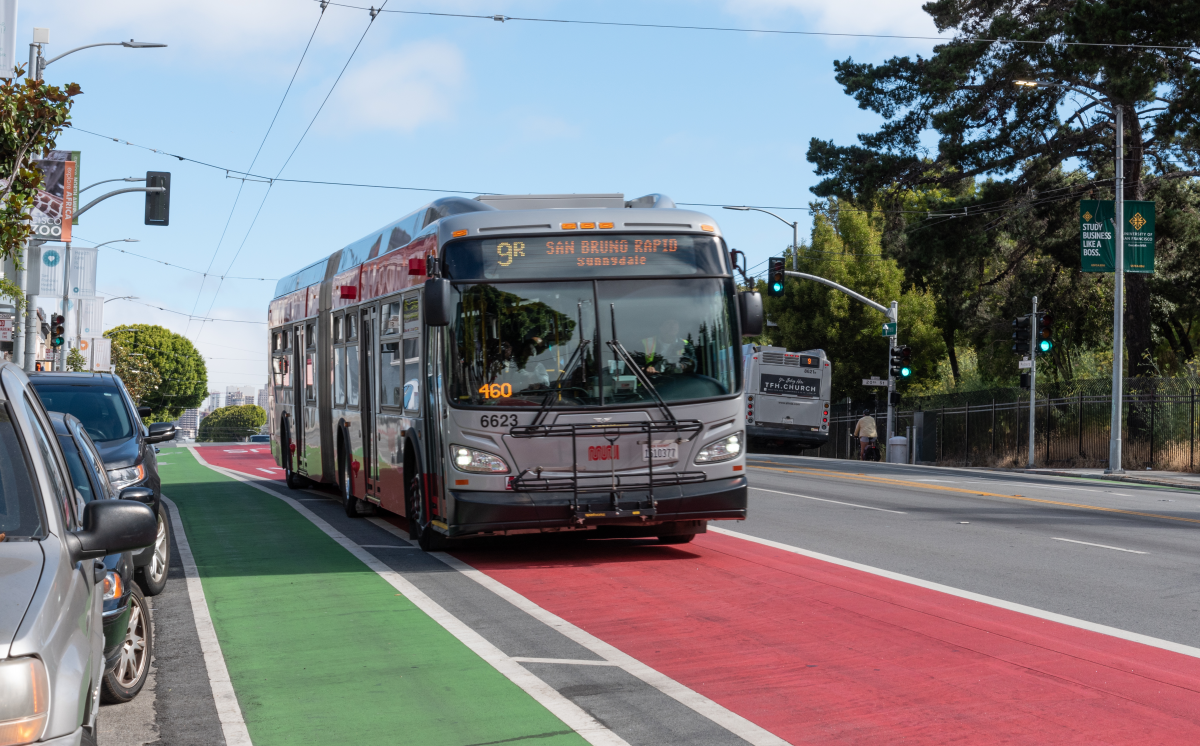
Beginning Saturday, May 16, the SFMTA will increase the frequency on a number of lines in Muni’s existing COVID-19 Core system and reinstate the 9R San Bruno Rapid. This more frequent service will continue to support essential trips in San Francisco and address crowding in several of our routes, allowing for better physical distancing.
We are able to deliver these changes because our staffing availability has improved, and we have implemented additional bus cleaning programs. These changes allow us to make service frequency increases to our COVID-19 Core service network.
Public health orders require Muni to limit capacity on our vehicles to provide enough space onboard to physically distance from others. By having buses arrive more frequently on routes experiencing higher passenger volumes, we can provide customers more room to physically distance. These improvements allow Muni to continue to support essential trips that cannot be made in other ways.
Ridership data is facilitating precise decision-making about where to increase the frequency of Muni service. Weekday frequencies on the following routes will be improved by two to four minutes, and they will all operate at frequencies of 10 minutes or less:
- 8 Bayshore
- 14R Mission Rapid
- 22 Fillmore
- 38R Geary Rapid
- 49 Van Ness/Mission
- N Bus
- T Bus
The 14 Mission Owl frequency will be improved by 10 minutes for both weekday and weekend service and will operate approximately every 20 minutes from 10:00 pm to 5:00 am.
On weekdays, the 9R San Bruno Rapid will also be restored to support physical distancing, help alleviate crowding on the 9 San Bruno line and add more frequent service to Zuckerberg San Francisco General Hospital. The 9R San Bruno Rapid and 9 San Bruno lines will resume their regular routing. When the 9R San Bruno Rapid is in service to McLaren Park on weekdays from 7:00 am to 6:00 pm, the 9 San Bruno will terminate on Bayshore at Visitacion. At all other times, the 9 San Bruno will go to McLaren Park. Further 9R details are provided in our transit and travel update.
-
9R San Bruno Rapid: Frequency approximately every 10 minutes from 7:00 am to 6:00 pm (Weekdays only)
-
9 San Bruno: Frequency approximately every 10 minutes from 5:00 am to 10:00 pm (Weekdays and weekends)
Map of Core Service that will be in effect as of Saturday, May 16:
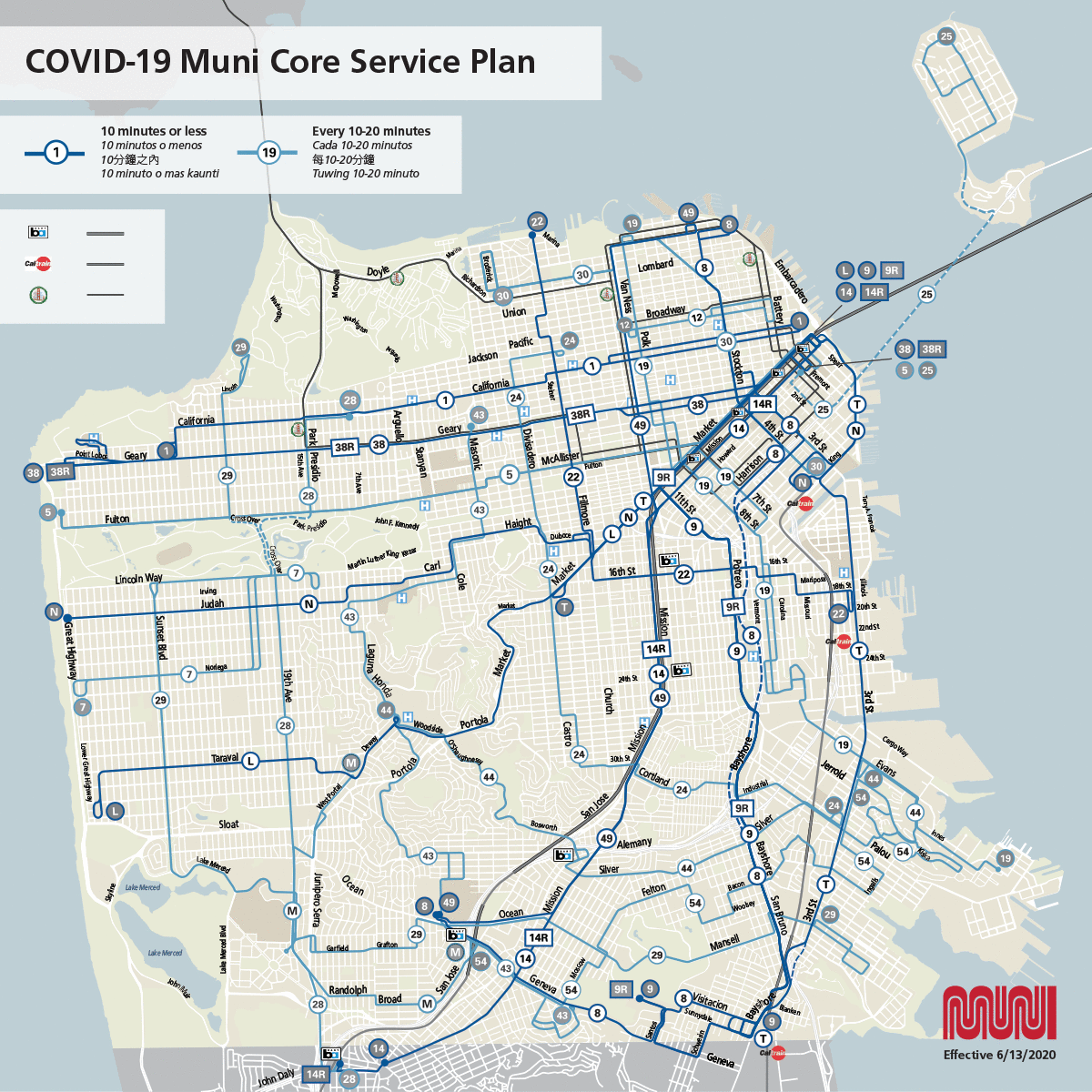
Access a larger map of service in effect May 16 that also displays regional transit connections and can be downloaded.
The modified COVID-19 Core Service Plan is in support of essential trips that cannot be made in other ways. All San Franciscans are helping us maintain adequate space on buses for physical distancing by continuing to stay at home except for essential trips. If you need to make an essential trip, please use an alternate form of transportation whenever possible – walking, biking or driving – to save a seat on Muni for those who don’t have other options.
If you do need to travel on Muni, give yourself extra time. You may need to wait longer for a bus with available space for physical distancing. Masks or face coverings are required on Muni. To avoid getting passed up, cover your nose and mouth with a mask or other facial covering and give the operator a friendly wave to be sure they see you. Remember, your trip may now include transfers and a longer walk, and your fare is good for two hours across multiple buses.
Visit SFMTA.com/COVID-19 for the latest information about Muni routes in service or to explore other ways to get around the city.
Published May 14, 2020 at 11:56PM
https://ift.tt/2WQ70mA
Wednesday, May 13, 2020
Everyday Heroes: Taxi Driver Corey Lamb
By Sarah Hellman
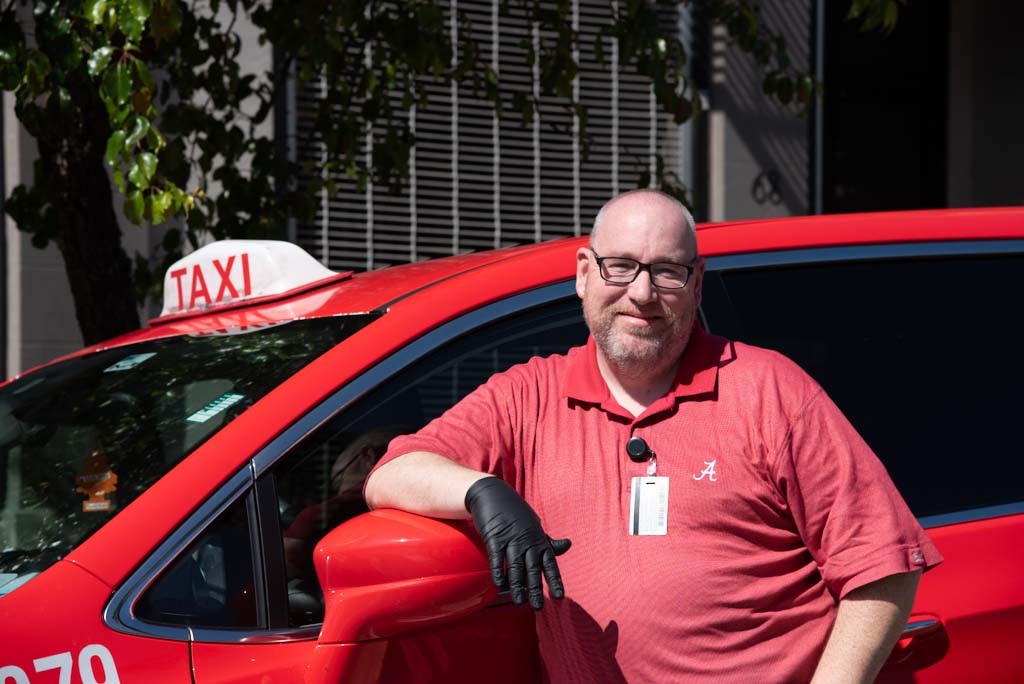
Corey Lamb shown without his face mask for the purposes of this photo only.
Corey Lamb is a veteran taxi driver with over 10 years of experience, and one of our unsung heroes. Corey provides at least 50 trips each month to wheelchair users who are unable to use Muni's accessible but regular fixed-route service. And during the shelter in place order, he has been actively transporting patients to needed medical appointments — patients like San Francisco resident Amelia Sison.
Lamb is representative of the many taxi drivers who are working hard during this health emergency to serve the needs of our most vulnerable residents who need to take trips for essential services.
For Sison, Lamb is her lifeline to the community. Since her necessary medical treatments began last year, Lamb has been her regular taxi driver, transporting her at least three times a week to and from appointments.
Awarded the 2019 Systemwide Paratransit Driver of the Year, Lamb has been an instrumental part of providing transportation to many seniors and individuals with disabilities through his participation in the city's ramp taxi program.
San Francisco launched the ramp taxi program in 1994 to ensure that wheelchair users had access to on-demand taxi service. Dedicated ramp taxi drivers like Lamb have made the city's ramp taxi program a leading model among paratransit programs in providing on-demand transportation services to wheelchair users.
For Lamb, this job isn't just about driving his passengers to their destinations — he has had the opportunity to meet people from all around the world. In 2019, he's met people from Canada, Spain, the UK, Sweden, India, Australia and from around the United States – all of whom use a wheelchair as their primary mobility method. Through his work, Lamb has assisted this community's independent lifestyle, treating each passenger with dignity and respect.
Know another driver or frontline SFMTA worker who’s doing a great job? Acknowledge those going above and beyond. Please share a photo (with their permission) along with their name and a quick description to SFTaxi@SFMTA.com. Some examples are:
- An everyday hero doing extra cleaning at your division
- Teammates getting creative to practice social distancing
- Something special a colleague did to support a team member during this challenging time
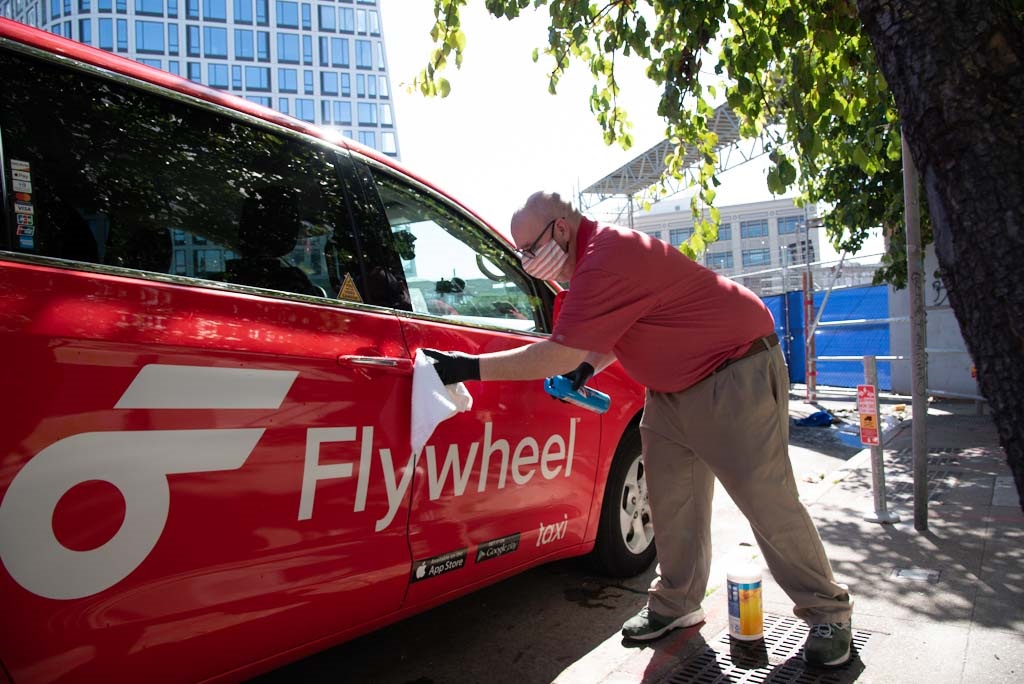
Published May 13, 2020 at 11:37PM
https://ift.tt/2Z1J2HU
Tuesday, May 12, 2020
Memorial Day Weekend Street Closures at Geary and Steiner to Remove Pedestrian Bridge
By Amy Fowler
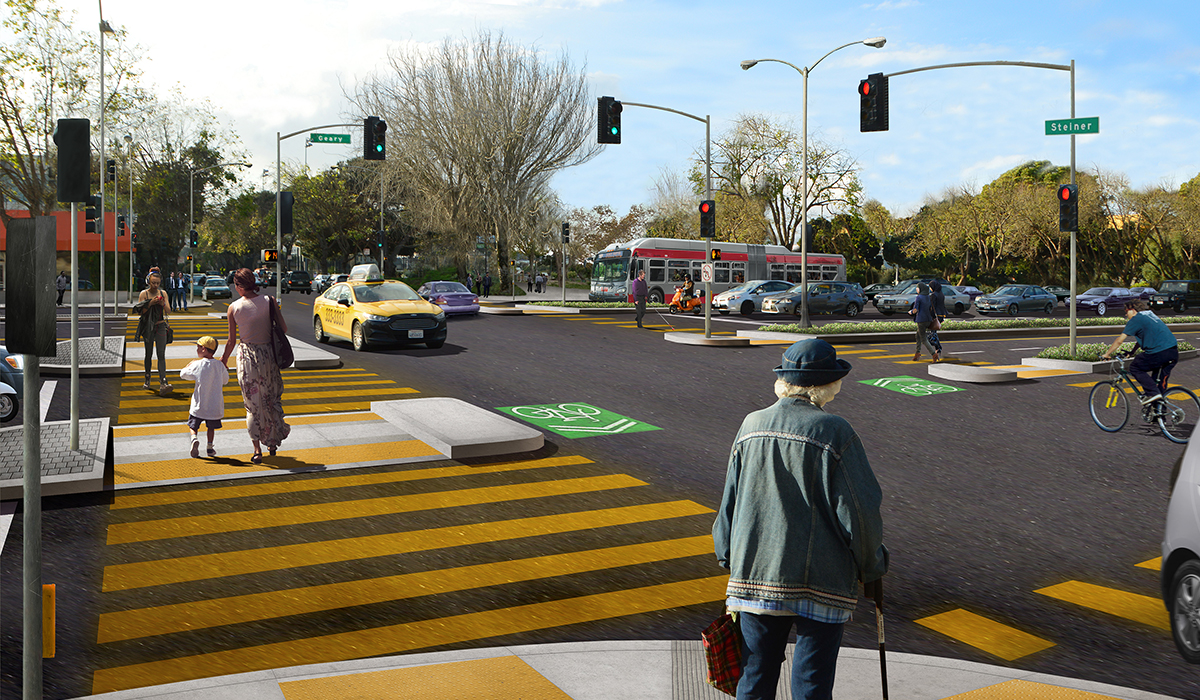
The future of Geary and Steiner, with the Steiner bridge removed and improved crosswalks and medians
The skyline on Geary Boulevard is about to change: this Memorial Day weekend, the pedestrian overpass at Geary and Steiner will be permanently removed.
Beginning at 8:00 p.m. Friday evening on May 22, the area around Geary Boulevard and Steiner Street will be closed to traffic while crews work to demolish the bridge. Work will continue for 24 hours a day until the demolition is completed, which could continue as late as Monday evening. During that time, vehicles will be rerouted and bus stops will be relocated. If you’re driving or taking Muni in the area, please allow extra travel time to get to your destination.
While removing the overpass may sound like a bridge too far, in this case it’s a bridge too steep. The Steiner pedestrian bridge was built in 1962, with 11-17% ramp slopes that far exceed the 5% limit that was later established by the Americans with Disabilities Act. The bridge’s support piers also reduce visibility of people crossing at the intersection. In place of the overpass, the SFMTA will be improving conditions for how people already prefer to travel—currently, over 80% of people on foot or wheelchair cross Geary and Steiner at street level.
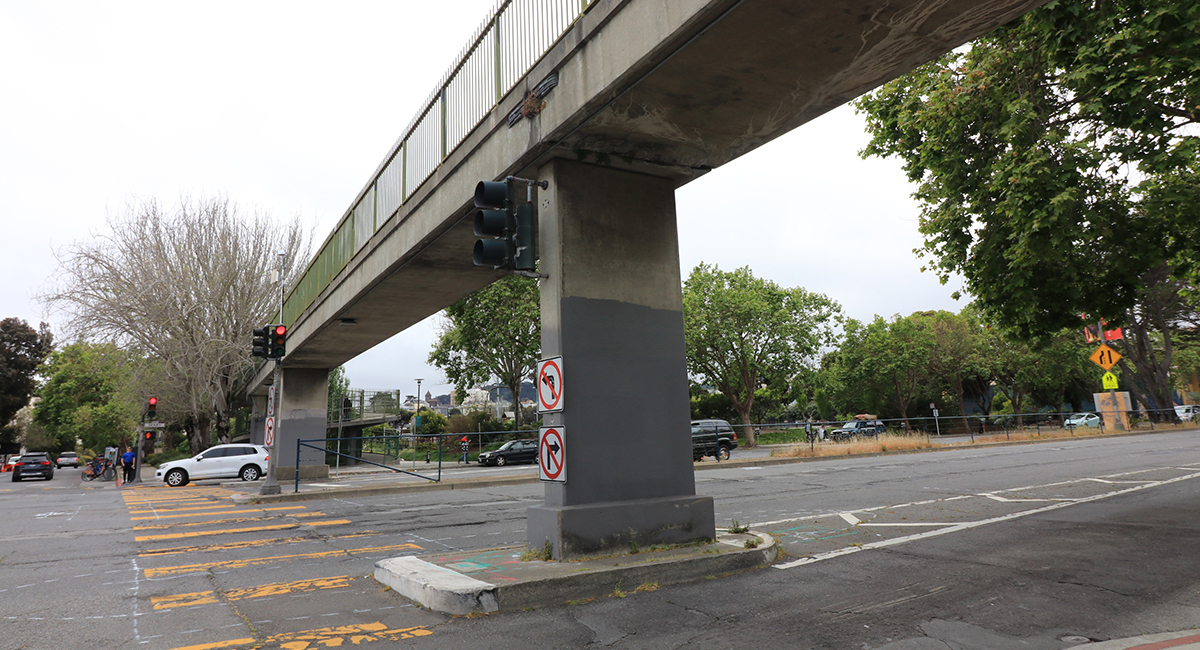
Get info about detours, bus stop changes and more at the Steiner bridge webpage
Later this year, the areas where the bridge ramps were will be repurposed for the adjacent San Francisco Recreation and Park sites. Hamilton Recreation Center will have a new stairway added at the northwest corner of Steiner and Geary, along with an expanded patio and new landscaping. The Raymond Kimbell Playground grassy area will also be expanded including a paved pathway rebuilt towards the intersection.
Towards the end of the project in 2021, after utility upgrades and street repaving are completed, a new surface crosswalk will be added on the east side of the intersection at Steiner. The existing crosswalk on the west side of the intersection will also be improved with larger pedestrian medians.
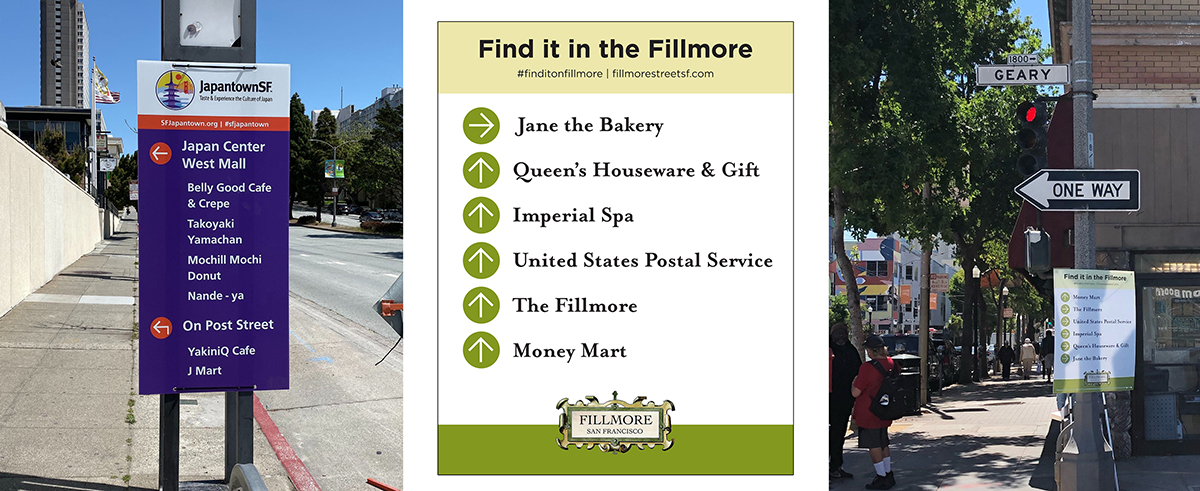
Local businesses and residences will remain accessible during the work, and wayfinding signs are being posted to help small businesses that are still open during the shelter in place order
Those hoping for a spectacle may be disappointed—the bridge won’t be imploded, but instead carefully dismantled and removed by Silicon Valley Demolition using two large five-axle mobile cranes, flatbed trailer trucks, and other large construction equipment.The spiral and folded ramps will be demolished in-place using hydraulic concrete processors to break up the structures; debris will be loaded into dump trucks for transport off-site. Crews are prepared to finish demolishing the bridge over the weekend, rain or shine.
The bridge removal is being overseen by San Francisco Public Works and is part of the Geary Rapid Project, which aims to improve bus service and pedestrian safety on the Geary corridor between Stanyan and Market streets. And it happens to correspond with another milestone—construction of the Geary Rapid Project has just reached its halfway mark and is expected to be completed on schedule in summer 2021.
Reroutes and Bus Stop Relocations
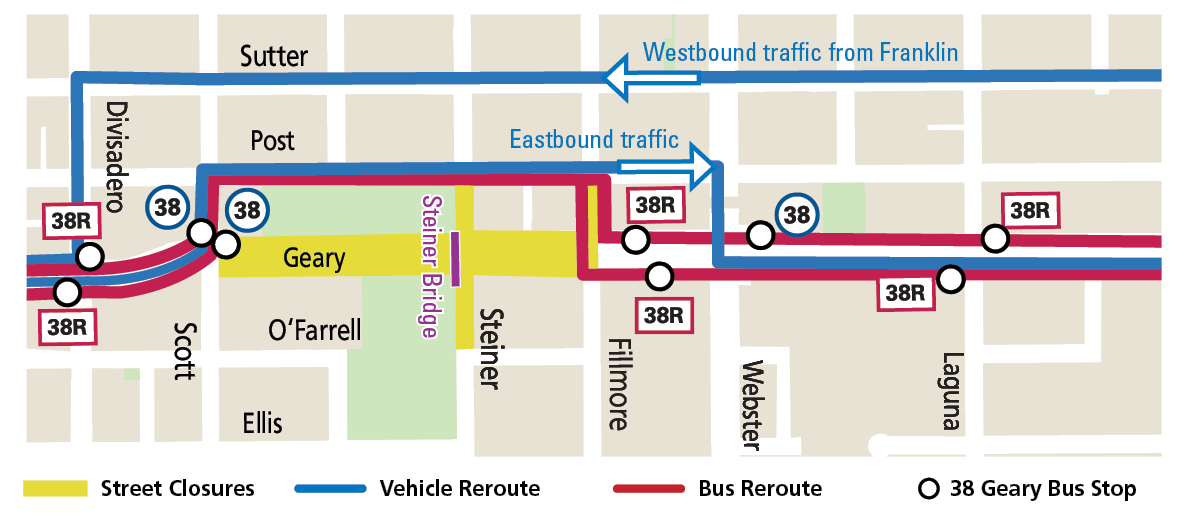
Map of detours and bus stop relocations during the bridge removal that starts Friday evening, May 22
Taking Muni
- 38/38R Geary buses will be rerouted to Post Street around the work zone and some bus stops will be temporarily relocated nearby. Look for “Board Here” signs.
Driving and Parking
- Streets will be temporarily closed to through traffic on Geary between Scott and Fillmore, on Steiner between Post and O’Farrell, and on Fillmore between Geary and Post streets with local access only.
- Vehicles will be rerouted to Sutter Street (westbound) and Post Street (eastbound).
- Some parking will be restricted within the street closure areas, at the relocated bus zones and at intersection corners along the detour route.
Walking or Bicycling
- Pedestrian detours will be provided around the work zone. People crossing Geary Boulevard north/south will need to cross at Scott or Fillmore Street.
- Cyclists can cross Geary at Webster Street.
- The Bay Wheels bike share station at Raymond Kimbell Playground will be closed.
Published May 13, 2020 at 03:09AM
https://ift.tt/35W5UcV
Friday, May 8, 2020
Your Market Street Muni Service FAQs - Answered
By Mariana Maguire
Even with temporarily reduced service and lower ridership across the Muni network amid the COVID-19 citywide stay-at-home health order, there are still multiple Muni Core Service routes overlapping along Market Street.
We’ve rolled out new tools to provide important information to customers who are still taking Muni for essential trips, including:
- The COVID-19 Ambassador Program along Market Street
- New wayfinding signage for bus routes along Market Street
- New signage about physical distancing and face coverings
- Multilingual onboard audio announcements and PSA car cards, social media campaigns, and a dedicated website at SFMTA.com/COVID19
Even so, we know our customers still have questions — read on to learn a bit more about our most frequent inquiries:
Which routes are operating on Market Street?
Since bus service replaced Muni Metro and light rail service to help us consolidate resources, the routes currently in operation along Market Street include:
- 5am-10pm: L Bus, N Bus, T Bus, 9 San Bruno, 5 Fulton, 38 Geary and 38R Geary Rapid
- 10pm-5am Owl: L Owl, N Owl, 38 Geary
Metro buses are only serving major stops - both island and curbs - on Market so they can move across the city quickly and serve the most riders.
Where are buses stopping along Market Street?
To help clear up where each bus route is supposed to stop, we’ve posted new wayfinding signs featuring the map segments below, showing customers exactly where they can find their bus.
Some bus stops are only served by Owl buses only right now, so check the wayfinding maps carefully. Some stops may only be in service after 10:00 p.m.
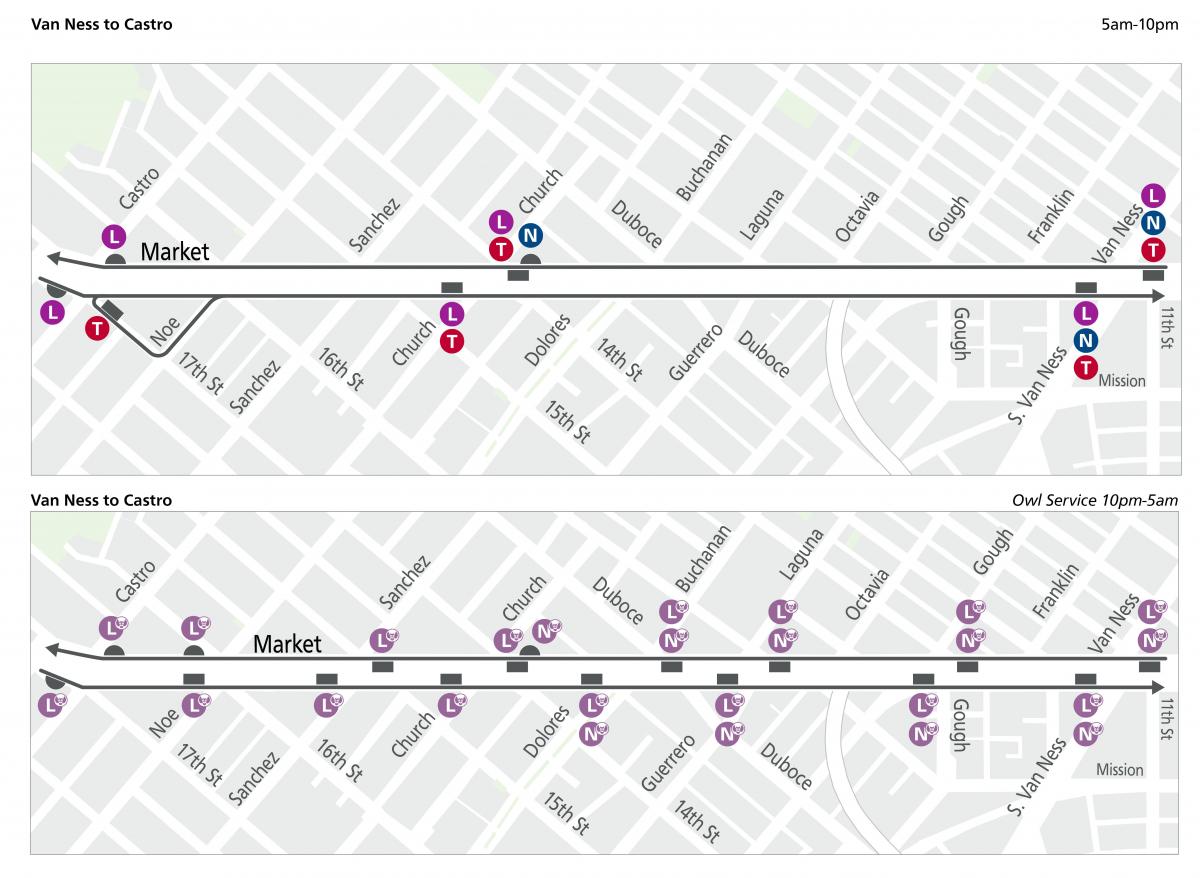
Wayfinding Muni stop maps for day and owl service from Castro to Van Ness. Rectangles indicate boarding islands. Half circles indicate curb stops.
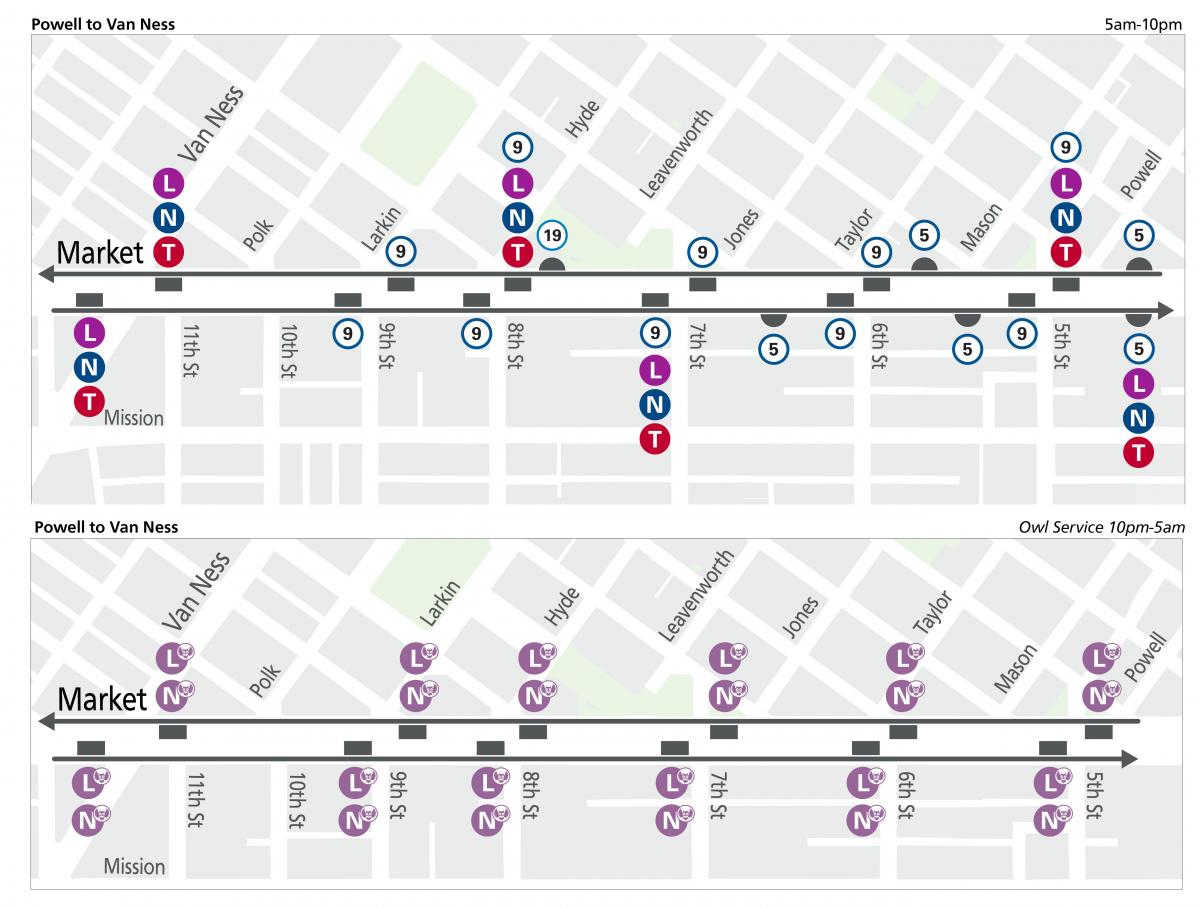
Wayfinding Muni stop maps for day and owl service from Van Ness to Powell. Rectangles indicate boarding islands. Half circles indicate curb stops.
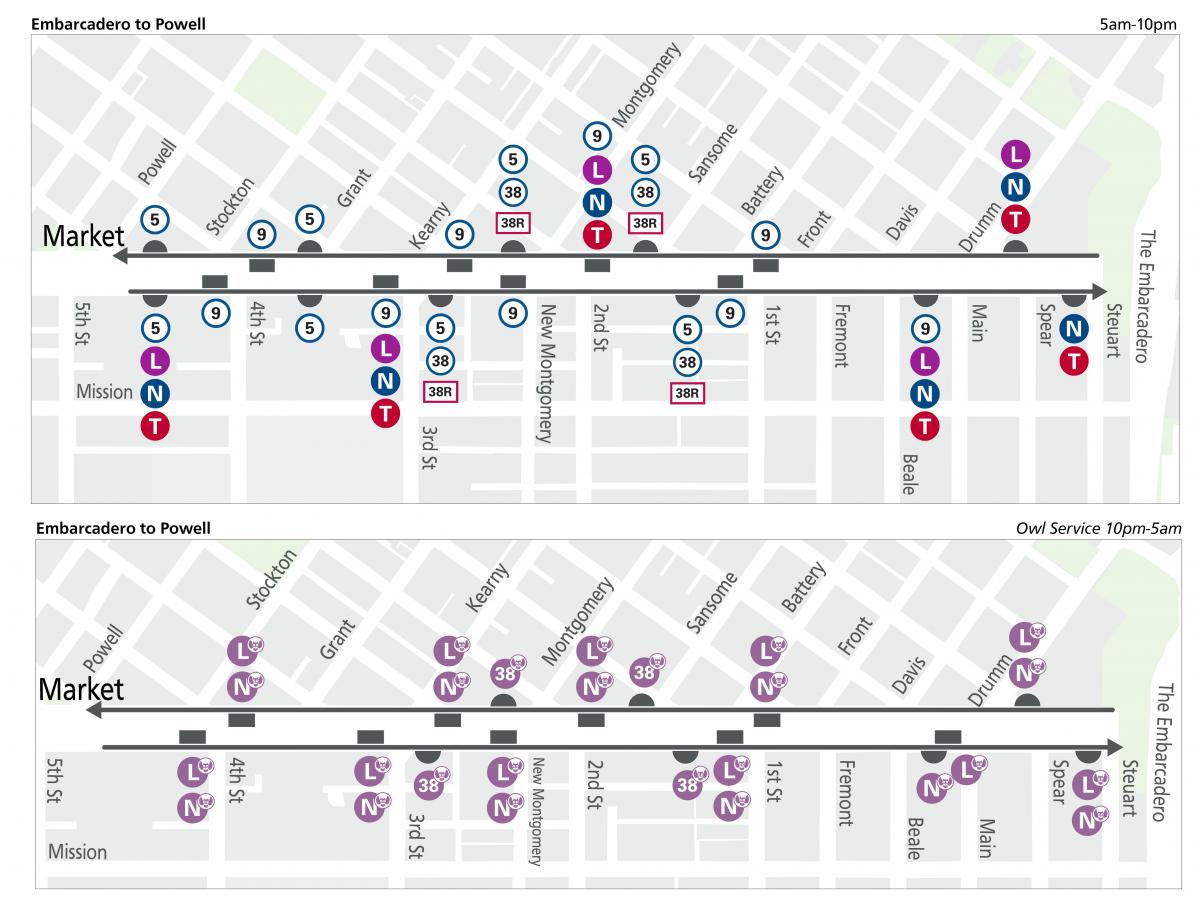
Wayfinding Muni stop maps for day and owl service from Powell to Embarcdero. Rectangles indicate boarding islands. Half circles indicate curb stops.
Why aren’t there more buses in service?
With fewer operators, car cleaners and maintenance staff available during the shelter-in-place, Muni service has been temporarily reduced to focus on core routes for people’s essential trips only. Based on data from customer travel patterns we’ve observed during the COVID-19 shelter-in-place, these routes represent the busiest lines with the highest demand. This core service provides connections to essential services like hospitals and grocery stores and is informed by Muni’s Equity Strategy to provide transportation for those with the fewest options.
Some routes are running approximately every 10 minutes or less, while others run every 10-20 minutes.
We will continue to make updates to Muni’s core service based on ridership trends, staffing availability, and community feedback.
Who should be riding Muni while we shelter in place?
Muni is currently operating for essential trips and should be used only if you don’t have another option. This is part of our effort to comply with the shelter-in-place order, support physical distancing and adjust to staffing availability. If you are an essential worker traveling to and from your essential work, or if you are taking an essential trip for health services, social services or food/grocery shopping, and you don’t have another way to make your trip, Muni Core Service is here for you.
If you are able to take other forms of transportation for any of these trips – such as walking, bicycling, or by taxi using our new Essential Trips Card program – we encourage you to do so. Every seat you save helps someone who needs it most right now and helps us maintain physical distancing on board our buses.
Why do some buses skip pickups?
Our priority is to keep core service going for customers to reach essential jobs and make essential trips. We are also a key agency in the City’s efforts to “flatten the curve” of COVID-19 transmission by encouraging physical distancing and requiring face coverings. Operators may bypass stops if their buses are getting too full for customers to maintain physical distance on board. They may also bypass stops if customers are not wearing face coverings -- so be sure to wear your mask or face cover over your nose and mouth, even while you are waiting for the bus. We know this is hard for customers, and we appreciate your understanding as we get through this together.
How can Muni customers keep physical distance on Market Street?
While you wait, use ground markings at Market Street bus stops to keep you physically distanced at stops. If you don’t see any pavement markings at your stop, be sure to allow about six feet between you and other customers.

Newly installed ADA and non-ADA Pavement decal markings for physical distancing at boarding islands on Market Street.
When your bus arrives, leave space as people are exiting the bus until it’s your turn to board. If a bus looks about half full, consider waiting for the next bus to help others maintain distance on Muni.
While you ride, keep as much physical distance as possible on board. We ask that customers use their best judgement and remember that if you are feeling crowded, please wait for the next bus.
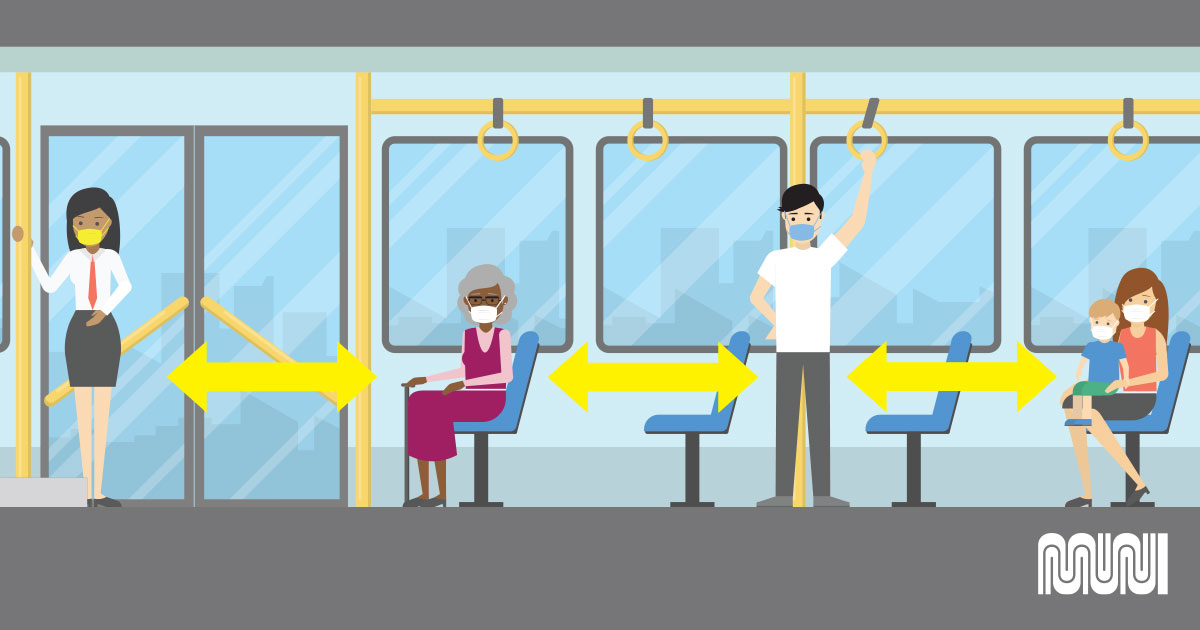
Graphic demonstrating physical distancing onboard Muni buses.
Do Muni customers have to wear face coverings?
YES! As of April 22, anyone riding Muni is required to wear face coverings. This is an official citywide health order. Your mask protects others, and their masks protect you. It’s an important way to prevent the transmission of COVID-19. Only board Muni if you are wearing a face covering. Wear your face covering when waiting for Muni too!
We have observed that most of our customers have taken this order seriously and are wearing face coverings at bus stops and onboard Muni buses. We appreciate everyone who has responded by doing their part. Thank you for wearing your masks, scarves and bandanas over your nose and mouth on Muni.
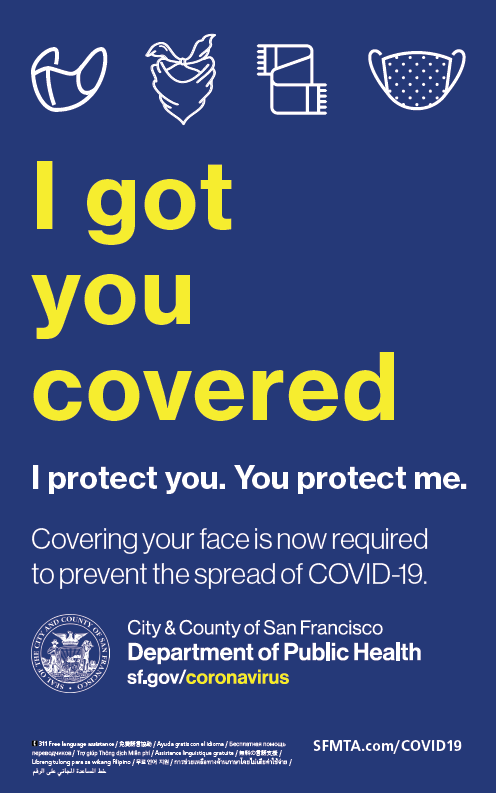
Sign describing the requirement to wear face masks or coverings.
Which doors should customers use to board Muni buses?
Use the rear doors only. The front doors are for wheelchair access and for people who need the kneelers to board. Remember, give people space as they are exiting the bus.
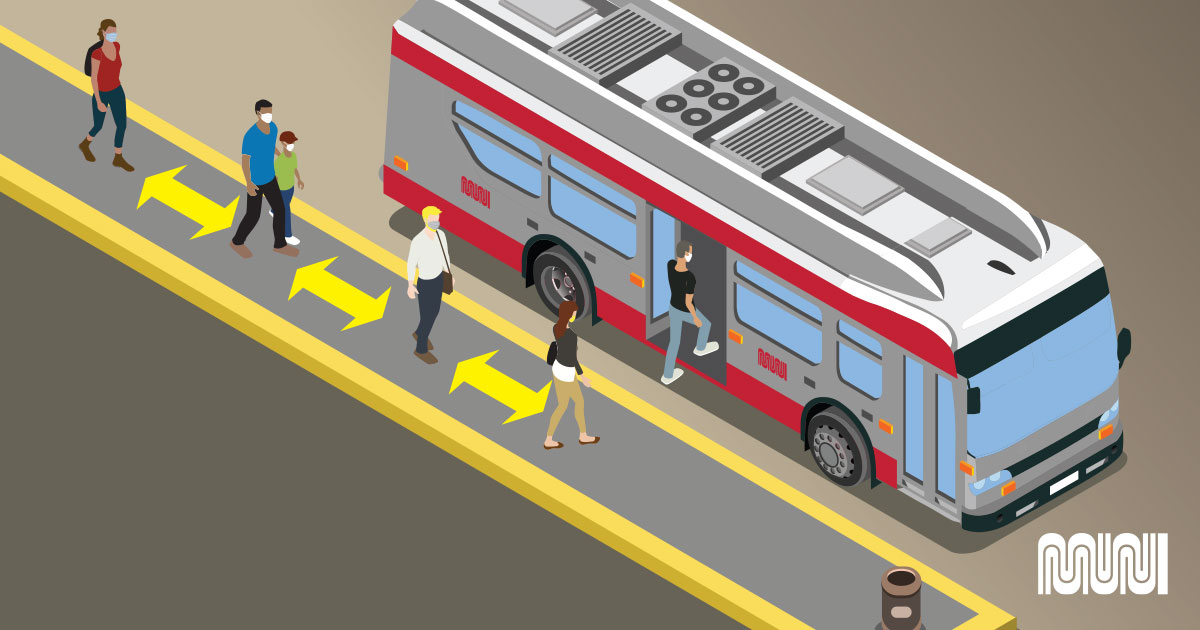
Graphic showing rear door boarding on Muni buses.
Why are streetcars and/or Light Rail Vehicles (LRVs) running sometimes?
These vehicles are not currently in service, but you may see some running along Market Street for maintenance reasons.
Got a burning question? Let us know.
Published May 09, 2020 at 05:11AM
https://ift.tt/2yDu2F2
Monday, May 4, 2020
Director of Transportation Report: April 21, 2020
By
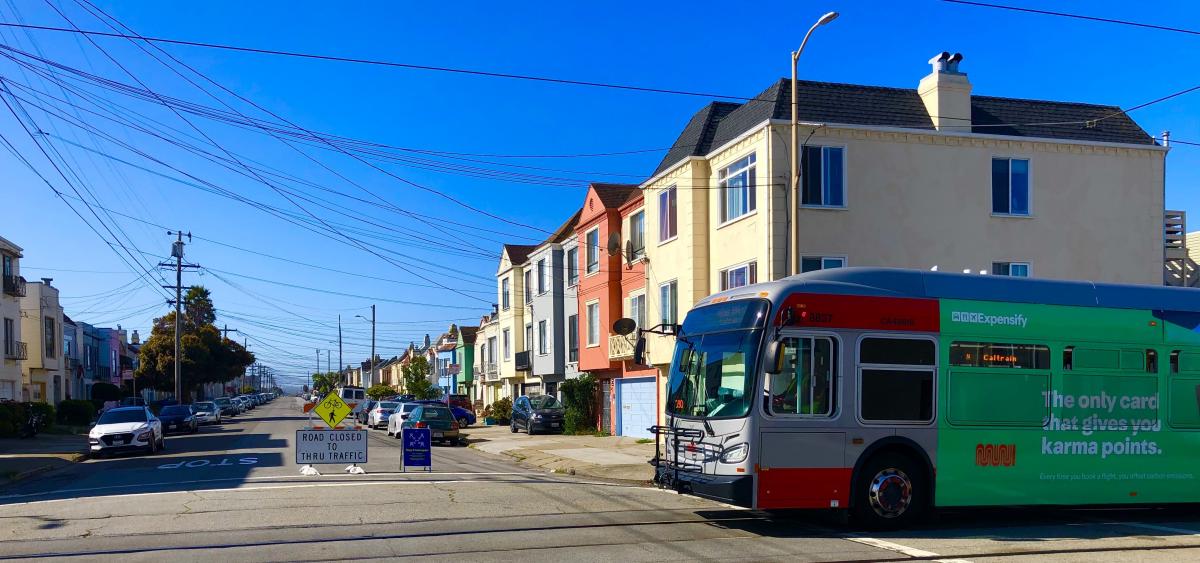
In this week's Director's Report from the SFMTA Board of Director's Meeting, Jeffrey Tumlin gave updates on the following topics:
- The agency’s ongoing response to COVID-19
- Ambassador program with agency staffing assisting transit in monitoring bus ridership along Market Street
- How the Essential Trip Program is helping to subsidize taxi use for older customers and those with disabilities
- Launch of the Slow Streets Program that will provide a network of streets that prioritize other modes besides public transit for essential trips while still allowing local vehicle traffic.
- Caltran’s US 101 Alemany Replacement Project shifting work to begin earlier on April 25
- Status on the closure of the Great Highway following an early April sand event
- Third Street Bridge and bicycle traffic
The SFMTA Board of Directors generally meets on the first and third Tuesday of each month at 1 p.m. in Room 400, City Hall. The meeting is open to staff and the public, or can be livestreamed through SFGovTV.
Published May 05, 2020 at 03:05AM
https://ift.tt/2YAlnOy
Friday, May 1, 2020
M Bus Community Shuttle Starts Service Monday 5/4
By Erin McMillan
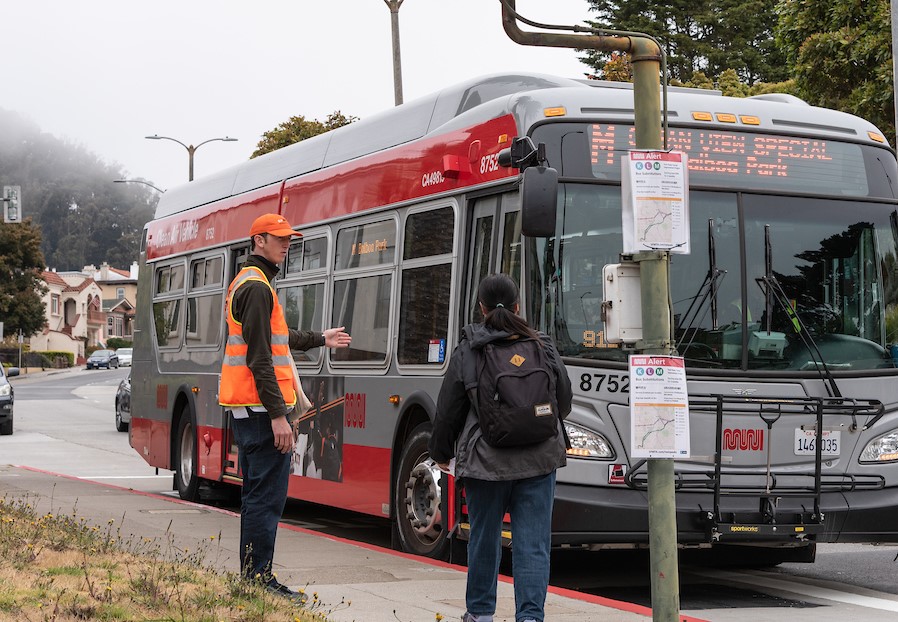
Starting Monday, May 4, the M Bus will return to partial service as a “Community Shuttle” between Balboa Park and West Portal stations. This service update is based on ridership trends, staffing availability, and community feedback. It has strong support from District 11 Supervisor Safai as a way to improve transit connections in the southwestern area of the city. The modified M Bus Community Shuttle route will provide better access for essential trips in the Ocean View, Merced Heights and Ingleside neighborhoods and to the transit hubs of West Portal and the Balboa Park. Serving stops on weekdays only from 6 a.m. to 9 p.m., the M Bus frequency will be approximately every 20 minutes.
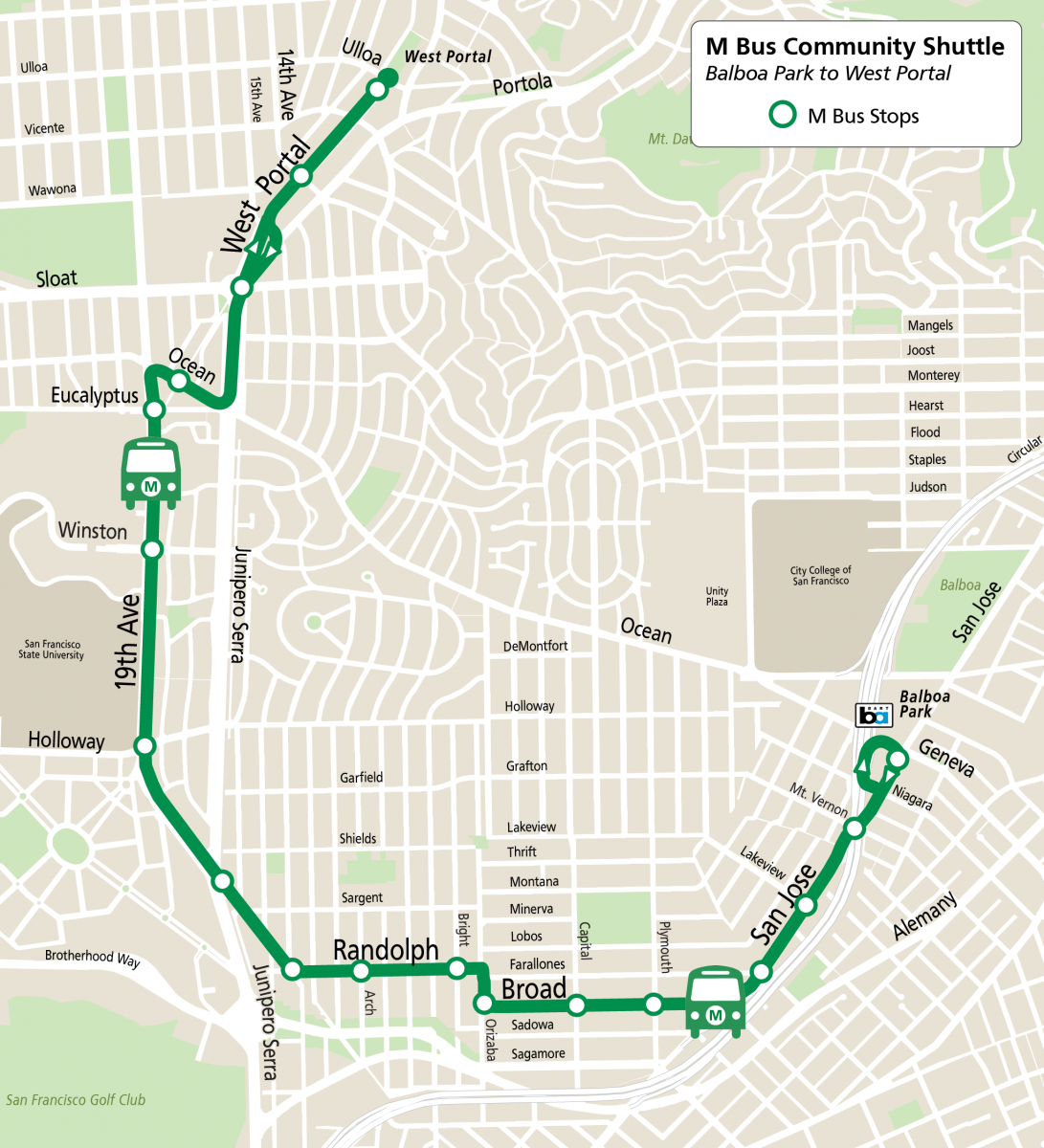
Since April 8, Muni has been operating a COVID-19 Core Service Plan to support essential trips that cannot be made any other way. With fewer operators, car cleaners and maintenance staff available during the shelter-in-place, Muni service has been temporarily reduced. The initial network and subsequent changes are informed by data on where ridership is highest, our Muni Equity Strategy to provide transportation for those with the fewest options, locations of essential services like hospitals and groceries, and to provide coverage across the city.
Muni still serves approximately 100,000 passengers a day for essential trips. We are asking all San Franciscans to help us maintain adequate space on buses for physical distancing by staying at home except for essential trips. Staying home or walking, biking or driving instead saves a seat on Muni for those who don’t have other options. You may see some of our staff at select bus stops helping to reinforce this message to our customers.
If you do need to travel on Muni, give yourself extra time. You may need to wait longer for a bus with available space for physical distancing. Masks or face coverings are required on Muni. To avoid getting passed up, cover your nose and mouth with a mask or other facial covering and give the operator a friendly wave to be sure they see you. Remember, your trip may now include transfers and a longer walk, and your fare is good for two hours across multiple buses.
Published May 02, 2020 at 03:45AM
https://ift.tt/2WgYRqZ